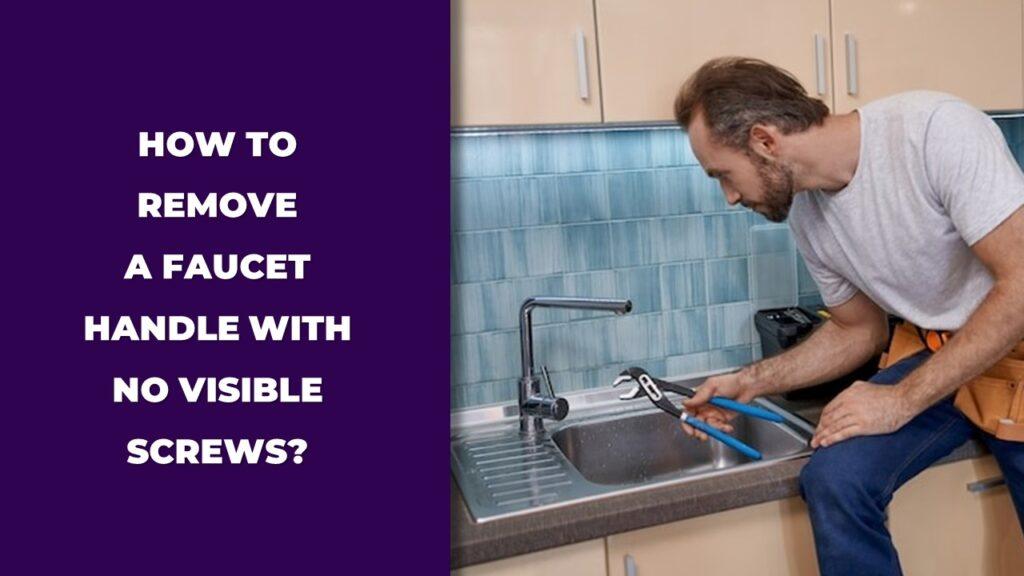
If you’re trying to take off a faucet handle but don’t see any screws, here’s the trick: most handles hide screws under a small cap. Check the top or sides of the handle for a tiny cover, then gently pop it off with a flat-head screwdriver or a butter knife. Underneath, you’ll usually find a screw, loosen that, and the handle should slide off. If there’s no screw, it might be a push-fit design, so give the handle a little twist or pull. If it’s stuck, try some oil or a special puller tool.
This article covers how to spot hidden screws, tools you’ll need, and what to do when the handle won’t budge, step by step, simple and clear.
Why Can’t I See Any Screws on My Faucet Handle?
If you can’t see any screws on your faucet handle, it’s probably because they’re hidden under a small cap. That cap is there for looks—it makes the handle look clean and smooth. You’ll usually find it right on top of the handle or maybe tucked on the side. Gently pry it off with a small screwdriver or even a butter knife, and the screw should be hiding underneath.
Most of the time, that’s all there is to it. But I know, it can be frustrating when you don’t see a cap either. In some cases, the handle might not have screws at all. It could be a push-fit design, meaning you just pull it straight off. The thing is, you won’t know for sure until you give it a closer look or a little tug.
It’s normal to feel stuck here—literally and mentally. So I’ll walk you through what to check, what to try, and when to just grab the right tool or call it a day. This doesn’t have to turn into a big headache.
Why Do Some Faucet Handles Have No Visible Screws?
Some faucet handles don’t show any screws because the design hides them for a cleaner look. The screws are usually tucked away under a small cap. If there’s no cap, it could be a push-fit handle, which means no screws are holding it at all—it just slides on and off.
The Hidden Screw Design Explained
A lot of faucets, especially newer ones or fancy designs, use a cap that hides the screw underneath. It’s mostly for looks, but it also keeps water from getting into the screw area. So yeah, they want it to look nice, but it can be a pain when you’re trying to take it apart. Just find that cap, pop it off, and you should see the screw right there.
Common Faucet Types with Hidden Screws
You’ll see hidden screws on a lot of single-handle kitchen faucets, bathroom sink faucets, and even shower handles. Brands like Moen, Delta, Kohler—they love this hidden screw thing. Some faucets might have a small set screw on the side or back, while others skip screws completely and just slide on. It all depends on the faucet.
Tools You’ll Need (And Why)
Alright, let’s talk tools. You don’t need a huge toolbox, but a few basics help. A flat-head screwdriver or a plastic card is handy for prying off caps. If there’s a hidden screw, it’s usually a Phillips or an Allen screw, so have those ready. Sometimes the handle is just stuck because of gunk or corrosion, and you’ll need some WD-40 or a special tool called a handle puller.
Essential Tools
- Flat-head screwdriver or plastic card (for popping off caps)
- Phillips or Allen wrench (to loosen the hidden screw)
- Flashlight (to see what’s going on in there)
- Adjustable wrench (if the handle is stuck tight)
- Soft cloth (so you don’t scratch the faucet)
Optional Tools
- Handle puller (for really stubborn handles)
- WD-40 or penetrating oil (if the handle is stuck)
- Vinegar (to clean off mineral buildup)
Most of the time, it’s just a screwdriver and a little patience. But if it feels stuck, don’t force it too hard—you don’t want to mess up the faucet. Try some oil or the puller if you need to. That’s the deal.
Step-By-Step Guide: How to Remove a Faucet Handle with No Visible Screws
Here is a step-by-step guide for removing a faucet handle with no visible screws:
- Look closely for a small cap or cover on the handle.
- Gently pry the cap off with a screwdriver or an old card.
- Once off, check for a hidden screw under the cap.
- Loosen that screw, then pull or twist the handle off.
- If it’s stuck, try a handle puller or a bit of oil.
- After removing the handle, inspect and clean the parts before putting them back together.
Alright, now let’s go through each step a bit more. It’s not as tricky as it seems once you know what to look for.
Step 1: Look for a Hidden Cap or Cover
First, take a real close look at the handle—top, sides, bottom, wherever you can. Most times, there’s a tiny cap that hides the screw. It’s not always easy to see. Sometimes it feels like a little bump or a line that doesn’t quite match the rest of the handle. You might have to squint a bit or run your finger around the edge.
Step 2: Gently Pry Off the Cap
Once you find the cap, grab a small flat-head screwdriver or a plastic card—something thin. Just slide it under the cap and gently work it loose. It should pop off with a little patience. Don’t jam it too hard, or you’ll scratch the faucet. Just a little wiggle and it usually gives.
Step 3: Locate the Hidden Screw
Alright, with the cap off, you should see the screw. Could be a Phillips, an Allen, or even a flat-head. Some are tiny, so it helps to grab a flashlight if you’re having trouble spotting it. That screw is what’s holding the handle on, so that’s your next target.
Step 4: Pull or Twist the Handle Off
Once the screw is loose, you can try to pull the handle straight up. If there’s no screw—some handles are weird like that—it might just pull off on its own. Sometimes you need to give it a little twist or a side-to-side wiggle. It’s like convincing a stubborn jar lid—it just needs a little encouragement.
Step 5: Use a Handle Puller if the Handle Is Stuck
Now, if the handle is being extra stubborn, that’s when you might need a handle puller. It’s a simple tool that grips the handle and helps lift it off. Really helpful if you’re dealing with an old faucet or one that hasn’t been touched in years.
Step 6: Apply Penetrating Oil for Stubborn Handles
If the handle feels like it’s glued on, try a little penetrating oil—WD-40 works fine. Spray a little around the base, wait a few minutes, and then give it another go. Sometimes the oil just needs a bit of time to loosen things up.
Step 7: Clean and Inspect the Handle and Faucet Parts
Once the handle’s off, take a look around. Check for any gunk, mineral buildup, or worn-out parts like O-rings. Give it a good wipe down with a cloth or a little vinegar if you see a lot of buildup. That’ll save you from dealing with the same headache later.
What If My Faucet Handle Still Won’t Come Off?
If the handle still won’t come off, don’t freak out. It’s probably stuck because of corrosion, a hidden clip, or it’s fused to the cartridge. Happens more than you think.
Common Problems and Solutions
- Corrosion or mineral buildup: Try soaking the area in vinegar or spray some more penetrating oil. Let it sit for 10–15 minutes and try again.
- Hidden clip holding the handle: Some faucets have a sneaky little clip. Look for a thin metal piece and gently pull it out with pliers.
- Handle fused to the cartridge: If the handle feels like it’s welded in place, you might be dealing with a stuck cartridge. In that case, it might be time to replace the whole thing.
Just remember—don’t force it too hard. You’ll risk breaking parts, and that’s a headache nobody wants.
When to Call a Plumber
If you’ve tried everything—pried, pulled, oiled—and the handle still won’t budge, it’s probably time to call a plumber. They’ve got the right tools and know how to handle tricky situations. If you see cracks, leaks, or something looks broken, better to let a pro handle it before things get worse. Sometimes it’s worth paying a little extra just for the peace of mind.
Maintenance Tips to Avoid Stuck Faucet Handles
If you want to avoid the headache of a stuck faucet handle, a little maintenance goes a long way. Wipe down your faucet regularly, check for buildup, and don’t let grime sit for too long. Every few months, take a look at the handle, and if it feels sticky or hard to turn, give it a quick clean.
It’s a good habit to wipe around the base of the handle with a damp cloth, especially if you’ve got hard water. That stuff loves to leave behind deposits that can mess things up over time. A bit of vinegar now and then can help, too—just don’t go overboard or you’ll damage the finish.
If you want to go the extra mile, use a small drop of plumber’s grease or silicone-based lubricant on the stem. That keeps everything moving smoothly without seizing up. It’s not a big job, and trust me, it’s a lot easier than dealing with a stuck handle when you’re in a rush.
Troubleshooting Table: Quick Fixes for Common Handle Issues
Here’s a quick table to help you figure out what’s wrong and what to do about it:
| Problem | Likely Cause | Solution |
| Handle won’t budge | Corrosion, buildup | Vinegar soak, penetrating oil, puller |
| No visible screws | Hidden cap, push-fit design | Pry cap, check seams, pull gently |
| Handle feels loose | Worn screw, loose stem | Tighten or replace screws |
| Handle stuck after cleaning | Mineral residue in stem | Clean stem, lubricate, reassemble |
Sometimes the problem is simple, like a loose screw. Other times, it’s that sneaky buildup that creeps up over months. Either way, take a minute to check things over before you dive in. A little patience and the right fix can save you a lot of time.
Final Thoughts
So, if you’re sitting there wondering how to remove a faucet handle with no visible screws, it really comes down to taking a good look and figuring out what you’re working with. Check for that hidden cap, grab a screwdriver, and take your time with it. Don’t force anything—faucet parts aren’t as tough as they look.
If the handle’s stuck, try some oil, maybe a handle puller, and clean up any grime or buildup you see. And hey, if you’ve done all that and the handle still won’t budge, it’s okay to call in a pro. Sometimes it’s just not worth the hassle.
Remember, a little maintenance here and there—like wiping down your faucet or using a bit of lubricant—can keep your handle working smoothly for years. Don’t wait for it to jam up before you give it some attention. Keep it simple, and you’ll save yourself the headache later.
Related FAQs
Can I remove a faucet handle without any tools?
Yes, some push-fit handles slide off without tools, but many need a screwdriver to remove a hidden screw.
How do I know if my faucet uses a push-fit handle?
If there’s no cap or screw visible after a close look, try gently pulling the handle. If it slides off with a bit of force, it’s a push-fit.
Will removing the handle damage the faucet?
No, as long as you go slow, use the right tools, and don’t force it. If it feels stuck, stop and try oil or a puller.
What if my handle has a clip instead of a screw?
Some faucet handles have a hidden clip. Look carefully for a small metal piece holding the handle in place—use pliers to remove it.
Should I replace the faucet if I can’t remove the handle?
Not always. If the handle is stuck due to buildup, try cleaning, oiling, or a handle puller first. If the faucet is damaged, then consider replacing it.

Dylan Foster is a family man with years of hands-on experience in plumbing, household maintenance, and fixing everyday issues around the home. A former plumber, Dylan knows what it’s like to deal with tricky leaks, worn-out parts, and all the little problems that pop up in a house. From plumbing repairs to kitchen fixes and garden hose setups, he’s done it all. Dylan shares real-world solutions to help others keep their homes running smoothly and avoid costly mistakes.




